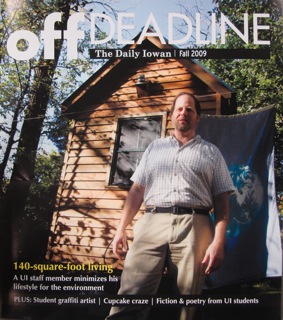Effective Living > Housing > Building Green | Environment
 Summary. The Space of our Desire is a compelling story by Kurt Cunningham about smaller and simpler living. The story was featured in the Fall 2009 print version of The Daily Iowan magazine, Off Deadline and appeared in the online edition with the title Tiny Space, big dreams. A photo slideshow is also available.
Summary. The Space of our Desire is a compelling story by Kurt Cunningham about smaller and simpler living. The story was featured in the Fall 2009 print version of The Daily Iowan magazine, Off Deadline and appeared in the online edition with the title Tiny Space, big dreams. A photo slideshow is also available.
Excerpt. Below is an excerpt from the story.
Just off Melrose Avenue near the UI’s Boyd Law Building, nestled between two trees and propped up on a trailer bed, sits a house built in inches rather than feet.
This 140-square-foot dwelling is smaller than the average-sized dorm room and looks similar to a tree fort children long to own.
But for nearly six years, it has served as Gregory Johnson’s home.
The UI technology-support specialist doesn’t own a car, nor does he pay a mortgage. Until two months ago, the 45-year-old didn’t have running water or electricity. His tiny home had just the basic necessities — a loft, a place to store clothes, and a porch to read on.
The smell of camping lingers in the walls that span only as far as he can reach, and the cobwebs create an illusion of a log cabin pitched in the middle of the forest. But this small, quaint home sits on the east side of his parents’ property.
Although Johnson recently made the switch to a small apartment roughly twice the size of his tiny home, he said his goal to inform others of the benefits of simplistic living is not over.
“What I’ve learned over the last six years is that the fewer material objects one owns, the less stress one has,” he said. “Something all people can appreciate.”
As Johnson stood next to the porch — only wide enough for a folding chair — he said size was the only issue that kept him and his fiancée, Makur Jain, from continuing to live in the home. She noted with a laugh that she also needed a properly working bathroom.
Though Johnson knows this is not the most convenient lifestyle, he hopes people can take parts of his life and apply them to their own. He stressed that living with the basic essentials takes some getting used to, but it promotes a rewarding, eco-friendly way of life.
Developing a routine is at the core of successfully living in such a non-materialistic lifestyle. Johnson’s began in the summer of 2001.
“I would wake up, ride my bike to the gym [rain or snow], shower, and get ready there,” he said. “Then, I would go on with my day. I didn’t see the point of paying for something like water.”
Changing where and how he started his day, he was able to stay disconnected from the city’s grid and pay $15 to $30 a month on heat. He maintained a relatively normal lifestyle by taking advantage of utilities from different resources. Because Johnson didn’t have electricity or running water, he powered his appliances at work and showered at the gym.
“I made a few small changes and saved a lot of money,” he said.
Jain, a UI graduate student, said the first time she saw the house, she was taken aback by just how small it was.
“It was so dark the first time I saw his house,” she said and laughed. “I remember thinking, ‘OK, where is the rest of the house?’ ”
A native of Lucknow, India, she shares Johnson’s outlook on life. Her father instilled in her a lifestyle of having only necessary items while she was growing up, she said.
“He always told me if you need two pairs of shoes, OK, or if you need two outfits, OK, but don’t worry about having more than you need.”
Both Johnson and Jain are drawn to what they call the simple “college life” living style, where everything they own has a practical use.
In fact, they recently moved all their possessions into the bathroom at their new apartment in order for a maintenance crew to change the carpeted floor to hardwood.
“I think that is when I realized just how few things we own,” Jain said. In fact, the couple doesn’t even own a bed; they sleep on yoga mats and find it just as comfortable.
Johnson isn’t the first UI employee to live this way. With the help of a former UI art Professor Jay Shafer — now a co-owner of Tumble Weed Tiny House Co. in California — Johnson spent the summer in 2001 building his home and downgrading his way of living.
“I moved things out little by little,” Johnson said. “What I didn’t need I left behind. I wanted to know what it would be like to live as simply as possible.”
Shafer’s home designs have been featured by the New York Times, CNN, and even Oprah Winfrey. [More…]